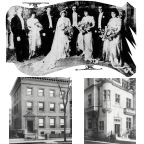|
Nelson Charles Clark (1858–1923), a traveling salesman for a
wholesale shoe distributor at the time of the Iroquois Theater fire, had married Alice
Gibbs Clark (1862–1960) in 1884. Verde and Edith were two of four children. Their home
on Ashland Avenue in La Grange Park Village of Cook County, Illinois was sandwiched
between that of Nelson's parents, Charles and Lucinda Gibbs Clark, and his brother
Jason (all three structures still standing, on a pretty tree-lined street).
From around 1910 until his death Nelson operated a shoe store — in 1916 located at 20 South Fifth
Ave in La Grange.
By 1920 the Clarks moved to 6th Avenue in Lyons, another Cook County township where
Alice would live most of the forty years after his death.
Later in life Nelson became an avid golfer, establishing the Nelson C. Clark trophy
in the 1911 season of the
Edgewood Golf Club of La Grange, indicating he was
probably one of the founding members. The trophy was offered in June the year
after the opening of the club's initial nine-hole course. Nelson was himself a club
trophy winner until at least 1920.
In some ways Edith and Verde Clark's lives followed similar paths. Each became a teacher
before marriage,▼1 and they each had three children.
Their lives after that took different turns.
In 1918, after graduating from La Grange High School in 1910, then the University of Chicago, Verde Alice Clark
(1892–1989) married Everett Dwight Graff (1885–1964). Graff
had gone to work for Joseph Ryerson & Son Steel as a young man in 1906. At retirement from
the firm in 1951 he'd served thirteen years as president and helped steer the company through
its 1935 merger with another Chicago company: Inland Steel. He got one of the
seats on the expanded Inland Steel board of directors and served until 1956.
|

|
It might be that Graff had purchased, or over twenty-nine years was rewarded with, a
pile of stock in Ryerson that after the merger turned into a pile of money from the sale
of Inland stock. The year following the Ryerson-Inland merger, the Graffs
exhibited new wealth by building a new
Regency-styled home with formal gardens on 1.6 acres at
20 Fox Lane in Winnetka, an upscale Cook County township north of Chicago. With over six
bathrooms and seven bedrooms in 7.8k square feet, a decade ago it sold for over five million dollars.
Graff's occupation provided a comfortable lifestyle for his family that included international
travel, society events, debutante balls, book and art collections, and philanthropy.
Everett was a trustee and officer of the Chicago Art Institute and his
donation to the Newberry Library of his ten-thousand-piece Western Americana book collection
was a significant contribution. Verde joined Everett in his activities, serving as
an officer in the Art Institute's Antiquarian Society and loaning artworks from their home to museums.
The Graff's also made financial contributions to hospitals, churches and other Chicago
organizations.
The year that Verde's family moved into their new home on Fox Lane had an altogether
different end for her sister. Edith Marian Clark
(1885–1936) and her husband, Alfred J. Coxeter (1878–1936), died in an auto
accident when a blown tire caused Alfred to side-swipe a truck.
Alfred had owned a
woolen company in 1920 but it might have been a casualty of the Depression because he
was an insurance agent in the 1930s. Their home on S. 6th Avenue, built in 1914, was
very nice, but her little sister Verde had become part of a different world and their
names did not appear together in society newspaper tidbits.
Edith's son Charles R. Coxeter served in WWII and in the 1960s his grandson, John Coxeter, worked as
a reporter for the South Bend Tribune newspaper, where he would have known my late
father-in-law,
Bill
Cooke, editor/reporter of the paper's Elkhart office.
|





